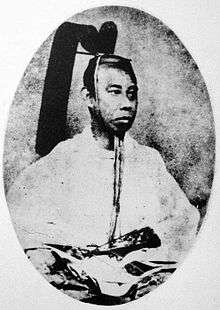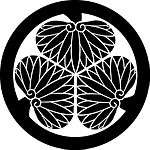Matsudaira Yoshinaga
| Matsudaira Yoshinaga | |
|---|---|
 Matsudaira Yoshinaga | |
| 16th Lord of Fukui | |
|
In office 1838–1858 | |
| Preceded by | Matsudaira Narisawa |
| Succeeded by | Matsudaira Mochiaki |
| Personal details | |
| Born |
October 10, 1828 Edo, Japan |
| Died |
June 2, 1890 (aged 61) Tokyo, Japan |
| Nationality | Japanese |
| Spouse(s) | Hosokawa Yū |
Matsudaira Yoshinaga (松平 慶永, October 10, 1828 – June 2, 1890), also known as Matsudaira Keiei,[1] or Matsudaira Shungaku (春嶽) was a Japanese daimyo of the Edo period. He was head of the Fukui Domain in Echizen Province.[2] He is counted as one of the "Four Wise Lords of the bakumatsu" (幕末の四賢侯 Bakumatsu no Shikenkō), along with Date Munenari, Yamauchi Yōdō and Shimazu Nariakira.
Early life
He was born as the eighth son of Tokugawa Narimasa in Tayasu house of Edo Castle. In his early life he was called "Nishikino-joh". Nishikino-joh was designated to be adopted to Matsudaira Katsuyoshi, the lord of Iyo-matsuyama Domain before he was born, and it was officially announced on November 25, 1837.
On July 27, 1838, Nariyoshi matsudaira, a young lord of Fukui Domain suddenly died. As he has no sons, the wife of the former lord of Fukui, Shoso-in, and Tokugawa Ieyoshi, the 12th Shogun (he was also a brother of Nariyoshi) decided to adopt Nishikino-joh to Matsudaira Family. He succeeded Echizen-Matsudaira family and a position as a ruler of Fukui in his age of 11. After his Gen-puku (coming of Age ceremony), he named himself as "Yoshinaga", after the name of Shogun IeYOSHI. "Yoshinaga" is his imina and "Shungaku" (春嶽: Spring Mountain) is his gō.
As a Local Ruler
On April 6, 1839, his marriage with Princess Yu, a daughter of Lord Hosokawa Narimori of Kumamoto Domain, was accepted by Shogunate.
At the same year, he decided to cut half the salary of all his samurai retainers and also his own expense for five years to restore financial health of Fukui. In January 1840, the discharge of Matsudaira Shume, the centre of conservative party enabled reformists such as Nakane Yukie to lead the Domain politics. Supported by Nakane, Yuri Kimimasa and Hashimoto Sanai, Yoshinaga performed innovative work such as establishment of translation bureau "Yogaku sho (foreign knowledge centre)" and military renovation.
Participation to the National Affairs
In 1853, when Matthew Perry's fleet came to Japan to demand free trade, at first Yoshinaga joined to anti-foreigner party with Tokugawa Nariaki (Mito-Tokugawa family) and Shimazu Nariakira (Satsuma Domain Lord). However, later he changed into pro-trading party after contact with Roju (Shogunate councilor) Abe Masahiro.
When the succession problem of 14th Shogun arose, he delegated his retainer Hashimoto Sanai to Kyoto to support Tokugawa Yoshinobu, the lord of Hitotsubashi-Tokugawa family. However, accession of Ii Naosuke, who was the lord of Hikone Domain as well as a strong supporter of Tokugawa Iemochi (Kishu-Tokugawa family), as Tairō (Chief councilor of Shogunate) resulted in the accession of Iemochi as the 14th Shogun. Succeeding ratification of Treaty of Amity and Commerce between US and Japan by Shogunate without acceptance of the Emperor infuriated Yoshinaga, and he intruded to Edo castle with Tokugawa Nariaki to protest against Naosuke. On 5 July 1858, he was accused on a charge of incursion to the Castle and forced to resign the post of the Fukui Domain Lord.
In the End of Tokugawa Shogunate
The assassination of Ii Naosuke in the Sakuradamon Incident changed the Shogunate's policy, allowing Yoshinaga to participate in politics in April 1862.
After the death of Shimazu Nariakira, his younger brother Hisamitsu came to Kyoto with his soldiers to attempt to influence the Imperial Court. Hisamitsu went to Edo with Ohara Shigenori the Imperial Envoy and demanded Yoshinobu's appointment as a Guardian of Shogun with Yoshinaga as a Tairo. On 4 August 1862, Yoshinaga was appointed President of Politics, a newly founded post and promoted the merger of the Imperial Court and the Shogunate as represented by the establishment of Kyoto Protecter Office (which is in charge of Kyoto security), the assignment of Matsudaira Katamori (Aizu Domain Lord) as a head of Kyoto Protector, and the re-settlement of Shogun Ieshige in Kyoto (Bunkyu Renovation). Yoshinaga invited Yokoi Shonan from Kumamoto Domain as a political consultant to renovate Fukui Domain and Shogunate politics.
The next year he himself moved to Kyoto, but pro-emperor and anti-foreigner sensation in Kyoto led by the Choshu Domain forced Yoshinobu into compromising with them. Yoshinaga quit as President of Politics in disappointment.
In June 1863, Yoshinaga and Yokoi Shonan’s plan making all of the samurai in Fukui Domain move to Kyoto under arms was announced. The details were as follows; 1. All samurai in Fukui Domain move to Kyoto led by Yoshinaga and new Lord Matsudaira Mochiaki and take control of Kyoto (and Japan). 2. In fair stances to both Imperial Court and Shogunate he eases conflict, makes a chance of dialogue, and promotes rapid and calm renovation with brain power from different backgrounds. In combination with Satsuma Domain he asked Higo and Kaga Domain to join, and Emperor himself accepted that plan. Although all Japanese was shocked by the news, opponents inside/outside the Domain and defects of communication with other Domains, Imperial Court, and Shogunate made it impossible to continue only before the day of carryout. This failure aroused ceaseless terrorism to Tokugawa Families by pro-Emperor party.
After purge of Choshu Domain by Aizu Domain and Satsuma Domain (18 August Affairs) and Kinmon Incident, Yoshinaga was appointed to be a Governmental Consultant, and move to Kyoto again. However, Consultant Committee system didn’t function well because of conflicts between consultants. Consultant Committee system fell apart soon after his appointment.
On 22 March 1864 he was appointed to be a Kyoto Protector instead of Matsudaira Katamori who became commander of the military, but resigned on 7 April.
In 1867, Yamauchi Yodo, ex-lord of Tosa Domain, and Date Munenari, ex-lord of Uwajima Domain, came to Kyoto by arrangement of Shimazu Hisamitsu. Yoshinaga, who was in Kyoto at that time, was persuaded to be a member of so-called Four-Lord Congress. this Congress was aimed to diminish the power of the Shogunate and establish council system by the Imperial Court and major domains. Four-Lord Congress was held eight times at Yoshinaga’s residence. In the congress including Yoshinobu, who had become the last Shogun, the main topic was opening of Hyogo (Kobe) Port to other nations and treating of Choshu Domain. Although Satsuma Domain tried to transit regime to Four-Lord Congress, Yoshinobu’s direct communication to Imperial Court made it impossible. Owing to the failure of Four-Lord Congress, Satsuma Domain moved to anti-Shogunate party with Choshu Domain.
On October 1867, Yoshinobu decided to return Shogunate regime to Imperial Court promoted by Tosa Domain and tried to maintain Tokugawa’s dominance as a leader of lords congress under control of Imperial Court. In subsequent war between Tokugawa ex-Shogunate and Choshu/Satsuma Domain (Boshin War) Yoshinaga acted as an intermediary. On 7 January 1868, an Imperial order to chastise Yoshinobu was officially announced. on 12 February Yoshinobu's declaration of surrender marked the end of the 260-year history of the Tokugawa Shogunate.
After Meiji Renovation
In new government he was assigned as Chief Executive of Internal Affairs, but soon he was forced resign all political posts because of rise of domain factionalism by Choshu and Satsuma.
Yoshinaga died at age of 63 in 1890. His death poem is “Even if I become one of countless souls, I would soar up to heaven and protect Emperor’s reign for our nation (Naki-kazu-ni/Yoshiya-iru-tomo/Amakakeri/Miyo-wo-Mamoramu/Sume-kuni-no-tame)”. His tomb is located at Kaianji-temple in Shinagawa, Tokyo.
In 1891 he was enshrined in Sakaeno-shrine with Shogunate founder Tokugawa Ieyasu and Domain founder Tokugawa Hideyasu. In 1943 his own shrine Fukui-Shrine was established.
Episodes
- Yoshinaga wrote letters inscribed on “Bunkyu-Eihou” coin minted at end of Shogunate.
- Yoshinaga named the regnal year “Meiji”.
- Yoshinaga is seen as one of the “Four Wise Lords at the end of Shogunate” together with Shimazu Nariakira (Lord of Satsuma), Yamauchi Toyonobu (Lord of Tosa), and Date Munenari (Lord of Uwajima). But he himself later said “ The real Wise Lord was Shimazu Nariakira only, and even Mito Lords, Yamaushi Yodo, Nabeshima Naotada and of course I cannot even come close to him."
See also
- Kamiyashiki of Matsudaira Tadamasa
- Ansei purge
- Fukui Prefectural Fujishima High School
- William Elliot Griffis
References

- ↑ Beasley, William G. (1955). Select Documents on Japanese Foreign Policy, 1853-1868, p. 335.
- ↑ Burks, Ardath W. (1985). The Modernizers: overseas students, foreign employees, and Meiji Japan, p. 56.
Further reading
- Beasley, William G. (1955). Select Documents on Japanese Foreign Policy, 1853-1868. London: Oxford University Press. [reprinted by RoutledgeCurzon, London, 2001. ISBN 978-0-19-713508-2 (cloth)]
- Kawabata, Taihei (1967). Matsudaira Shungaku. (Tokyo: Yoshikawa Kōbunkan).
- Mikami, Kazuo (2004). Bakumatsu ishin to Matsudaira Shungaku. (Tokyo: Yoshikawa Kōbunkan).
- Nihon-shi Jiten 日本史辞典. (Tokyo: Ōbunsha 旺文社)
- Totman, Conrad. The Collapse of the Tokugawa Bakufu, 1862-1868. Honolulu: University of Hawai'i Press, 1980.
External links
- "Fukui" at Edo 300 (Japanese)
- 越前松平氏 (Echizen Matsudaira) at ReichsArchiv.jp (Japanese)
| Preceded by Matsudaira Narisawa |
14th Lord of Fukui 1838-1858 |
Succeeded by Matsudaira Mochiaki |